 Research Article
Research Article
How to Unify the Definition of Shear Stress and Shear Strain in the Teaching of Mechanics Courses
Shencan LU* and Jiujiang Zhu
School of Civil Engineering and Architecture, Wuyi University, China
Shencan LU, School of Civil Engineering and Architecture, Wuyi University, China.
Received Date:June 22, 2023; Published Date:July 19, 2023
Abstract
In traditional textbooks on material mechanics and elasticity mechanics, the definition of shear stress differs by a positive or negative sign, and the definition of shear strain differs by twice. The stress and strain defined in elasticity are second-order tensors, so the definitions of shear stress and strain in elasticity are scientific. The purpose of this article is to explore how to unify the definitions of shear stress and shear strain in mechanics course teaching with those in elastic mechanics.
Keywords:Shear stress; Shear strain; Second-order tensor
Introduction
Yesterday, when my teacher gave me a mechanics class, they told me that the difference in shear stress defined in the textbooks of material mechanics and elasticity is a plus or minus sign, and the difference in shear strain defined in material mechanics and elasticity is twice. So, I firmly remembered this sentence as a truth. Decades later today, I stand on the podium and impart this sentence to my students in its original form. Will my students pass down this sentence from generation to generation intact tomorrow? The purpose of this article is to explore how to unify the definitions of shear stress and shear strain in mechanics course teaching.
History and Current Situation
Definition of shear stress in elasticity and material mechanics
As shown in Figure 1, the definition of the stress component in elasticity [1-2] is the projection of the surface force acting on a cross-section in the normal direction along the positive (negative) direction of the coordinate axis along the positive (negative) direction of each coordinate axis.
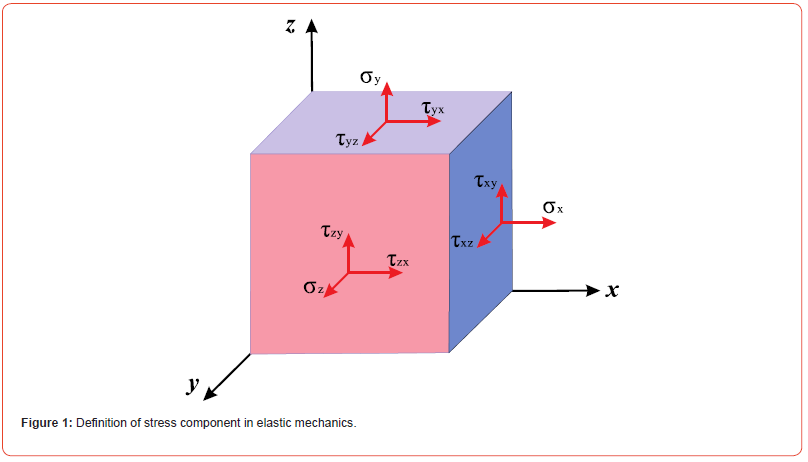
The normal direction of the section where the surface force is located is used as the first indicator of the corresponding stress component subscript, and the component of the surface force along which coordinate axis direction is used as the second indicator of the corresponding stress component subscript. The stress state defined in this way can be represented by a matrix as shown in Eq. (1).

According to the shear stress reciprocity theorem, the matrix in Eq (1) is a symmetric matrix, meaning that the stress tensor is a symmetric tensor. The stress state can be represented by the transposed matrix of the matrix in Eq (2).

In fact, the stress in Eq (2) is a second-order tensor. The stress state of two coordinate systems O-(e1, e2, e3) and O-(e1*, e2*, e3*) can be expressed as Eq. (2) and (3).

The coordinate systems (x, y, z) can be marked as (1, 2, 3) using the subscript notation. Therefore, the two coordinate systems convert as shown in Eq. (4).

Thus, the relationship between these two stress components satisfies the following transformation as shown in Eq. (5).

If the beam in Figure 2 is in a pure bending state. When the stress components defined by elasticity mechanics are used to study the bending state of the beam in Figure 2, the stress state in the material unit taken from the beam is shown in Figure 3.
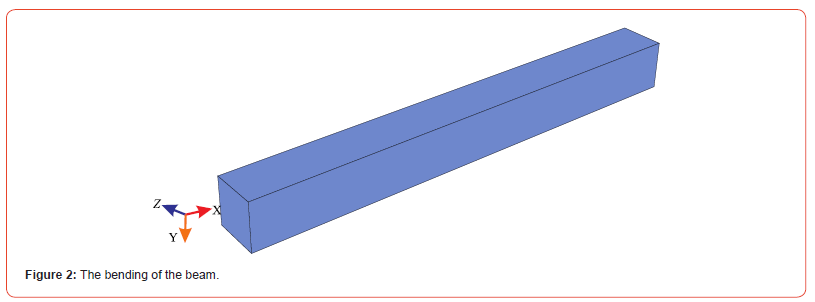
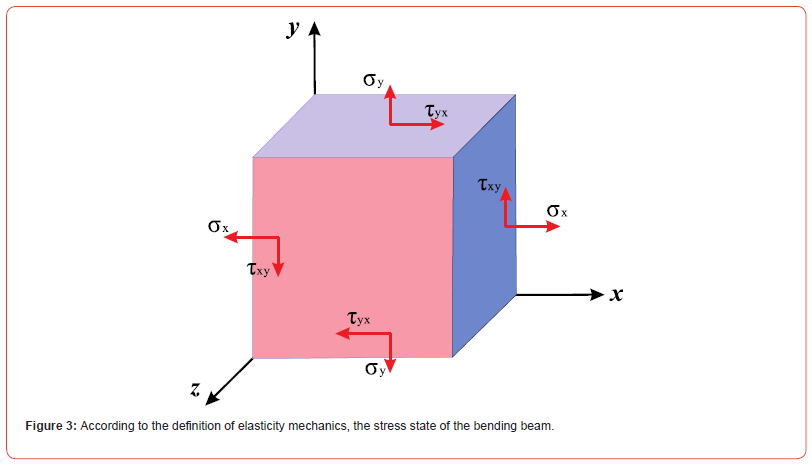

However, in the textbook of materials mechanics [3-4], when teaching beam bending, the definition of shear force in strength of materials is that the shear force that makes the beam rotate clockwise is positive, and the direction of shear stress is the same as that of shear force. According to this regulation, the stress state in the material unit taken from the beam is shown in Figure 4.
The shear stress defined in Figure 5 and Figure 3 differs exactly by a positive or negative sign. If shear stress is defined according to material mechanics, the matrix formed by the overall stress component is not a second-order tensor, which means it does not meet the coordinate transformation rule in Eq. (5). Therefore, defining shear stress according to material mechanics is not scientific. However, from the development history of mechanics, material mechanics emerged before elastic mechanics. The regulation of shear force signs is deeply rooted in material mechanics and difficult to change.
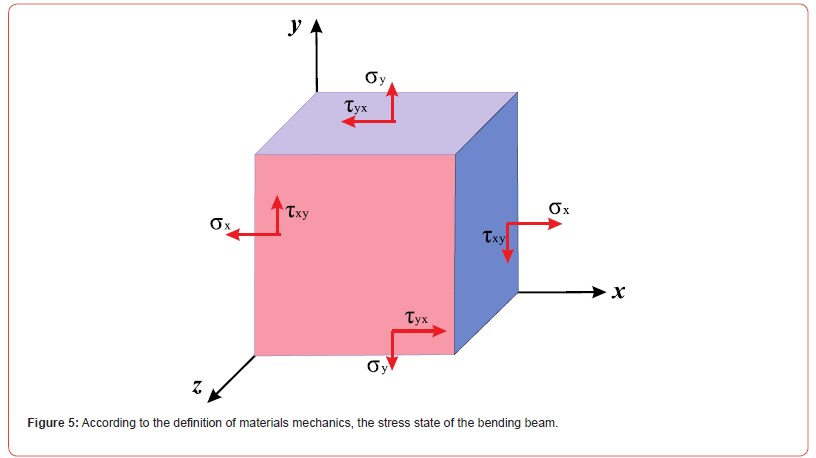
Definition of shear strain in elasticity and material mechanics
In textbooks on material mechanics, the definition of shear strain is the decrease in the right angle of two perpendicular line segments during deformation. In elasticity mechanics, the displacement vector u is a function of the spatial position vector r, using the subscript labeling method as shown in Eq. (6).

Thus, the deformation gradient can be expressed as Eq. (7).

Thus, the strain tensor can be defined as the symmetric part of the deformation gradient using Eq. (8).

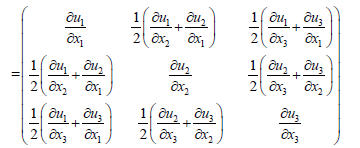
It can be proven that the strain components defined in equation (8) are exactly two mutually perpendicular line segments, and their right angles decrease by half during the deformation process, which showed that the strain defined in material mechanics is twice that of elasticity mechanics. It is not difficult to verify that the strain defined by equation (8) is a second-order tensor. The coordinate system transformation rule is expressed in Eq. (9).

It illustrated that defining shear strain according to equation (8) is scientific, while defining it according to material mechanics is unscientific. The different definitions of shear strain also can affect the definition of shear modulus.
Solution
Can we unify the definition of shear stress in elasticity and material mechanics? The answer is yes, and this contradiction can be solved by selecting an appropriate coordinate system when teaching beam bending. When the coordinate system in Figure 3 is rotated around the x-axis by 180°, or the coordinate system is established according to Figure 6, the definition of shear stress in material mechanics is perfectly unified with that in elastic mechanics, without changing the original definitions and habits of material mechanics and elastic mechanics. Therefore, the author proposes that the coordinate systems should be established uniformly according to Figure 6 in future textbooks and courseware on material mechanics, emphasizing the definition of shear stress in elastic mechanics, that is, the projection of the surface force vector on the front side in the positive direction of the coordinate axis. As shown in Figure 6, O-xyz is the right-hand coordinate system.
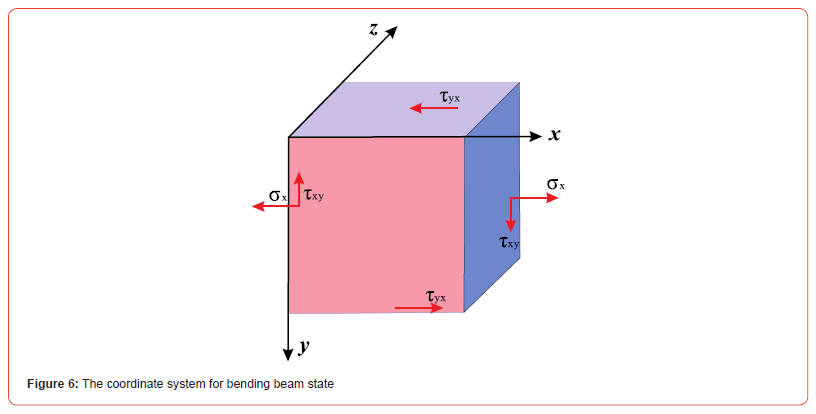
When teaching shear stress on oblique sections, a normal direction n and a tangent direction t should also be defined, so that the coordinate system O-ntz forms a right-hand coordinate system, as shown in Figure 7. Therefore, the shear stress on the inclined section can also be defined as the projection of the surface force vector on the inclined section along the positive direction of the coordinate axis t. It means that the definition of shear stress in elasticity mechanics is universal.
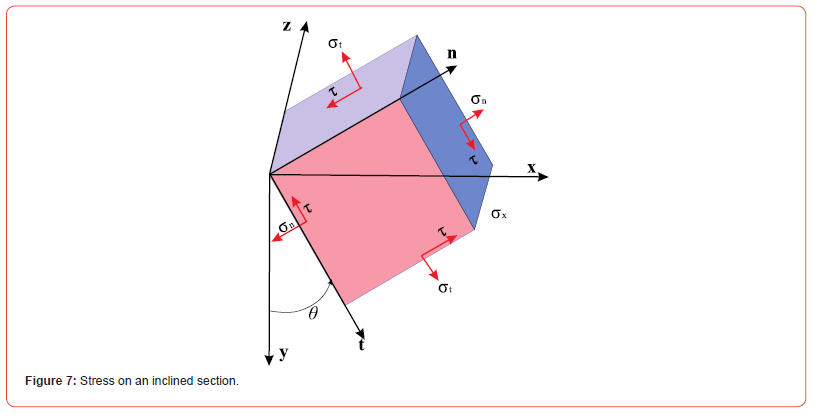
The only way to unify the differences between shear strains defined in elasticity and material mechanics is take unified action and change the definition of shear strain in material mechanics to half the amount of change at right angles. Therefore, the author of this article proposes that from now on, the material mechanics textbooks and courseware in the future be changed to be consistent with elastic mechanics.
Conclusion
When a unified standard is formed worldwide: (1) use the coordinate system shown in Figure 6 in material mechanics; (2) In material mechanics, the definition of shear strain is changed to half the reduction in right angles. As a result, in the teaching of mechanics courses, the contradiction of inconsistent definitions can be avoided. Convenient for teachers to teach, but also beneficial for students to learn
Acknowledgement
This research is supported by the project of “High Education funding of Guangdong Province: 2018KZDXM072”; “The postgraduate demo course project of Wuyi University: YJSSFKC2308”.
Conflicts of Interest
No conflict of interest.
References
- S Timoshenko JN, Goodier McGraw-Hill (1969) Theory of elasticity, Engineering societies monographs 1969 3d ed.
- S Timoshenko JM (1972) Mechanics of materials, Gere Van Nostrand Reinhold Co.
- Eringen, Ahmed Cemal, WH Müller (2020) Encyclopedia of Continuum Mechanics. Springer Berlin Heidelberg 2020.
- A Bedford KM (2020) Liechti Mechanics of materials, 2nd edition: © Springer Nature Switzerland AG 2020.
- Xunfang Sun, Xiaoshu Fang, Laitai Guan (2019) Mechanics of materials (in Chinese), Chinese High Education Publisher, Beijing.
-
Shencan LU* and Jiujiang Zhu. How to Unify the Definition of Shear Stress and Shear Strain in the Teaching of Mechanics Courses. Glob J Eng Sci. 11(2): 2023. GJES.MS.ID.000758..
-
Shear stress, Shear strain, Second-order tensor, Mechanics
-

This work is licensed under a Creative Commons Attribution-NonCommercial 4.0 International License.






